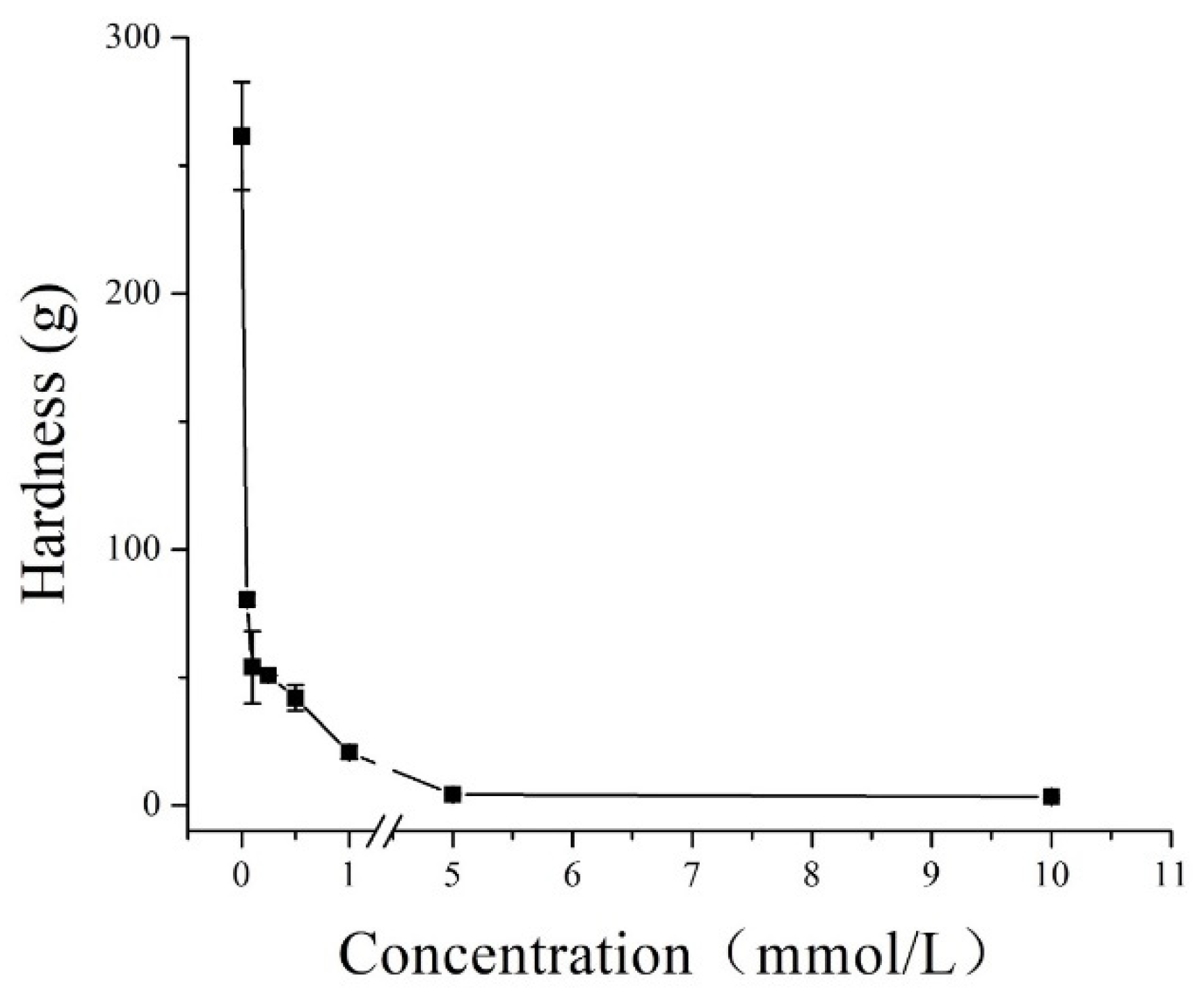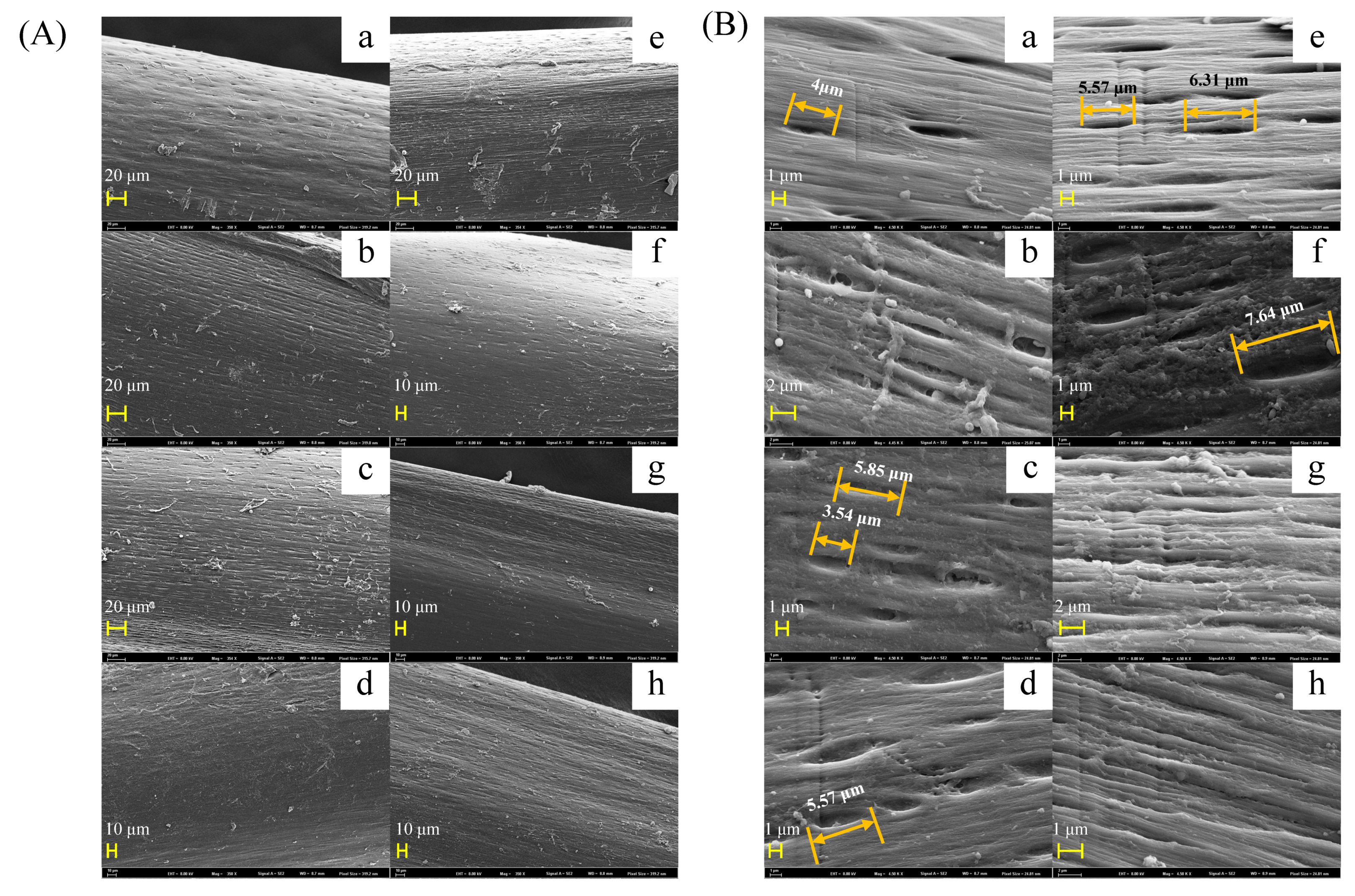Diluted Acetic Acid Softened Intermuscular Bones from Silver Carp (Hypophthalmichthys molitrix) by Dissolving Hydroxyapatite and Collagen
Abstract
:1. Introduction
2. Materials and Methods
2.1. Raw Materials and Preparation of IBs
2.2. Chemical Reagents
2.3. Number and Morphology of IBs
2.4. Microstructure
2.5. Sensory Evaluation
2.6. Determination of Hardness
2.7. Determination of Calcium, Phosphorus, and Collagen Content
2.8. Fourier Transform Infrared Spectroscopy (FTIR)
2.9. Statistical Analysis
3. Results and Discussion
3.1. Number and Morphology of Silver Carp IBs
3.2. Sensory Evaluation
3.3. Effect of Acetic Acid Concentration on the Hardness of IBs
3.4. Changes in IB Microstructure
3.5. Calcium, Phosphorus, and Collagen Contents
3.6. FTIR
4. Conclusions
Supplementary Materials
Author Contributions
Funding
Institutional Review Board Statement
Informed Consent Statement
Data Availability Statement
Conflicts of Interest
References
- FIGIS-Time-Series Query on: Aquaculture. Available online: https://www.fao.org/figis/servlet/SQServlet?file=/usr/local/tomcat/8.5.16/figis/webapps/figis/temp/hqp_7773031624479754477.xml&outtype=html (accessed on 21 November 2021).
- Lin, M.P.; Chen, Y.L.; Tzeng, W.S. Incarceration of a y-shaped fish bone in the upper thoracic oesophagus. BMJ Case Rep. 2014, 2014, 4742. [Google Scholar] [CrossRef] [Green Version]
- Song, S.; Liu, Z.; Huang, M.; Zhu, Q.; Qin, J.; Kim, M.S. Detection of fish bones in fillets by Raman hyperspectral imaging technology. Food Eng. 2020, 272, 109808. [Google Scholar] [CrossRef]
- Zhang, J.; Yin, T.; Xiong, S.; Li, Y.; Ikram, U.; Liu, R. Thermal treatments affect breakage kinetics and calcium release of fish bone particles during high-energy wet ball milling. Food Eng. 2016, 183, 74–80. [Google Scholar] [CrossRef]
- Viguet-Carrin, S.; Garnero, P.; Delmas, P.D. The role of collagen in bone strength. Osteoporos. Int. 2006, 17, 319–336. [Google Scholar] [CrossRef]
- Idowu, A.T.; Benjakul, S.; Sae-Leaw, T.; Sookchoo, P.; Kishimura, H.; Suzuki, N.; Kitani, Y. Amino acid composition, volatile compounds and bioavailability of biocalcium powders from salmon frame as affected by pretreatment. J. Aquat. Food Prod. Technol. 2019, 28, 772–780. [Google Scholar] [CrossRef]
- Landis, W.J.; Song, M.J.; Leith, A.; McEwen, L.; McEwen, B.F. Mineral and organic matrix interaction in normally calcifying tendon visualized in three dimensions by high-voltage electron microscopic tomography and graphic image reconstruction. J. Struct. Biol. 1993, 110, 39–54. [Google Scholar] [CrossRef] [PubMed]
- Larry Arsenault, A. Image analysis of mineralized and nonmineralized type I collagen fibrils. J. Electron. Microsc. Tech. 1991, 18, 262–268. [Google Scholar] [CrossRef] [PubMed]
- Rubin, M.A.; Rubin, J.; Jasiuk, I. SEM and TEM study of the hierarchical structure of C57BL/6J and C3H/HeJ mice trabecular bone. Bone 2004, 35, 11–20. [Google Scholar] [CrossRef]
- Wang, X.; Bank, R.A.; TeKoppele, J.M.; Hubbard, G.B.; Athanasiou, K.A.; Agrawal, C.M. Effect of collagen denaturation on the toughness of bone. Clin. Orthop. Relat. Res. 2000, 371, 228–239. [Google Scholar] [CrossRef] [Green Version]
- Caputo, I.; Lepretti, M.; Scarabino, C.; Esposito, C.; Proto, A. An acetic acid-based extraction method to obtain high quality collagen from archeological bone remains. Anal. Biochem. 2012, 421, 92–96. [Google Scholar] [CrossRef]
- Kittiphattanabawon, P.; Benjakul, S.; Visessanguan, W.; Nagai, T.; Tanaka, M. Characterisation of acid-soluble collagen from skin and bone of bigeye snapper (Priacanthus tayenus). Food Chem. 2005, 89, 363–372. [Google Scholar] [CrossRef]
- Venkatesan, J.; Kim, S.K. Effect of temperature on isolation and characterization of hydroxyapatite from tuna (Thunnus obesus) bone. Materials 2010, 3, 4761–4772. [Google Scholar] [CrossRef] [PubMed]
- Liu, Y.; Li, J.; Wang, D.; Yang, F.; Zhang, L.; Ji, S.; Wang, S. Enhanced extraction of hydroxyapatite from bighead carp (Aristichthys nobilis) scales using deep eutectic solvent. J. Food Sci. 2020, 85, 150–156. [Google Scholar] [CrossRef]
- Shimosaka, C.; Shimomura, M.; Terai, M. Changes in the physical properties and composition of fish bone cured in an acetic acid solution. J. Home Econ. Jpn. 1998, 49, 873–879. [Google Scholar] [CrossRef]
- Zhang, P.; Badoni, M.; Gänzle, M.; Yang, X. Growth of Carnobacterium spp. isolated from chilled vacuum-packaged meat under relevant acidic conditions. Int. J. Food Microbiol. 2018, 286, 120–127. [Google Scholar] [CrossRef] [PubMed]
- Carpenter, C.E.; Smith, J.V.; Broadbent, J.R. Efficacy of washing meat surfaces with 2% levulinic, acetic, or lactic acid for pathogen decontamination and residual growth inhibition. Meat Sci. 2011, 88, 256–260. [Google Scholar] [CrossRef] [PubMed]
- McDermott, A.; Whyte, P.; Brunton, N.; Lyng, J.; Fagan, J.; Bolton, D.J. The effect of organic acid and sodium chloride dips on the shelf-life of refrigerated Irish brown crab (Cancer pagurus) meat. LWT 2018, 98, 141–147. [Google Scholar] [CrossRef] [Green Version]
- National Rodent Laboratory Animal Resources Center. Available online: https://nrla.nifdc.org.cn/nrla/iacuc/xgzcfg/20201109180705182.html (accessed on 12 December 2021).
- Fiedler, I.A.K.; Zeveleva, S.; Duarte, A.; Zhao, X.; Depalle, B.; Cardoso, L.; Jin, S.; Berteau, J.P. Microstructure, mineral and mechanical properties of teleost intermuscular bones. J. Biomech. 2019, 94, 59–66. [Google Scholar] [CrossRef]
- Carmack, C.F.; Kastner, C.L.; Dikeman, M.E.; Schwenke, J.R.; García Zepeda, C.M. Sensory evaluation of beef-flavor-intensity, tenderness, and juiciness among major muscles. Meat Sci. 1995, 39, 143–147. [Google Scholar] [CrossRef]
- Wu, W.; He, L.; Liang, Y.; Yue, L.; Peng, W.; Jin, G.; Ma, M. Preparation process optimization of pig bone collagen peptide-calcium chelate using response surface methodology and its structural characterization and stability analysis. Food Chem. 2019, 284, 80–89. [Google Scholar] [CrossRef]
- Nie, C.H.; Hilsdorf, A.W.S.; Wan, S.M.; Gao, Z.X. Understanding the development of intermuscular bones in teleost: Status and future directions for aquaculture. Rev. Aquac. 2020, 12, 759–772. [Google Scholar] [CrossRef]
- Li, L.; Zhong, Z.Z.; Zeng, M.; Liu, S.J.; Zhou, Y.; Xiao, J.; Wang, J.; Liu, Y. Comparative analysis of intermuscular bones in fish of different ploidies. Sci. China Life Sci. 2013, 56, 341–350. [Google Scholar] [CrossRef] [Green Version]
- Junianto, J.; Iskandar, I.; Rizal, A.; Damayanti, W. The influence of concentration of acetic acid and pepsin enzyme in nilem fish skin collagen extractionto the amount of rendement Produced. World News Nat. Sci. 2018, 21, 164–170. [Google Scholar]
- Cohen, L.; Dean, M.; Shipov, A.; Atkins, A.; Monsonego-Ornan, E.; Shahar, R. Comparison of structural, architectural and mechanical aspects of cellular and acellular bone in two teleost fish. J. Exp. Biol. 2012, 215, 1983–1993. [Google Scholar] [CrossRef] [PubMed] [Green Version]
- Barth, H.D.; Zimmermann, E.A.; Schaible, E.; Tang, S.Y.; Alliston, T.; Ritchie, R.O. Characterization of the effects of x-ray irradiation on the hierarchical structure and mechanical properties of human cortical bone. Biomaterials 2011, 32, 8892–8904. [Google Scholar] [CrossRef] [Green Version]
- Boutinguiza, M.; Pou, J.; Comesaña, R.; Lusquiños, F.; De Carlos, A.; León, B. Biological hydroxyapatite obtained from fish bones. Mater. Sci. Eng. C 2012, 32, 478–486. [Google Scholar] [CrossRef]
- Nagai, T.; Suzuki, N. Isolation of collagen from fish waste material-skin, bone and fins. Food Chem. 2000, 68, 277–281. [Google Scholar] [CrossRef]
- Paschalis, E.P.; Mendelsohn, R.; Boskey, A.L. Infrared assessment of bone quality: A review. Clin. Orthop. Relat. Res. 2011, 469, 2170–2178. [Google Scholar] [CrossRef] [Green Version]
- Addison, W.N.; Nelea, V.; Chicatun, F.; Chien, Y.C.; Tran-Khanh, N.; Buschmann, M.D.; Nazhat, S.N.; Kaartinen, M.T.; Vali, H.; Tecklenburg, M.M.; et al. Extracellular matrix mineralization in murine MC3T3-E1 osteoblast cultures: An ultrastructural, compositional and comparative analysis with mouse bone. Bone 2015, 71, 244–256. [Google Scholar] [CrossRef]
- Liang, Q.; Wang, L.; Sun, W.; Wang, Z.; Xu, J.; Ma, H. Isolation and characterization of collagen from the cartilage of Amur sturgeon (Acipenser schrenckii). Process Biochem. 2014, 49, 318–323. [Google Scholar] [CrossRef]
- Davison, P.F.; Cannon, D.J.; Andersson, L.P. The effects of acetic acid on collagen Cross-links. Connect. Tissue Res. 1972, 1, 205–216. [Google Scholar] [CrossRef]
- Doyle, B.B.; Bendit, E.G.; Blout, E.R. Infrared spectroscopy of collagen and collagen-like polypeptides. Biopolymers 1975, 14, 937–957. [Google Scholar] [CrossRef] [PubMed]
- Pasteris, J.D.; Wopenka, B.; Freeman, J.J.; Rogers, K.; Valsami-Jones, E.; Van Der Houwen, J.A.M.; Silva, M.J. Lack of OH in nanocrystalline apatite as a function of degree of atomic order: Implications for bone and biomaterials. Biomaterials 2004, 25, 229–238. [Google Scholar] [CrossRef]
- Oxlund, H.; Barckman, M.; Ørtoft, G.; Andreassen, T.T. Reduced concentrations of collagen cross-links are associated with reduced strength of bone. Bone 1995, 17, 365–371. [Google Scholar] [CrossRef]





| In Vitro | In Vivo | ||||||||
|---|---|---|---|---|---|---|---|---|---|
| Concentration (mmol/L) | Hardness | Sharpness | Total Scores | Concentration (mmol/L) | Flavor of Fillets | Texture of Fillets | Hardness of IBs | ||
| Hardness | Sharpness | Total Scores | |||||||
| 10 | 8.61 ± 0.70 a | 8.78 ± 0.44 a | 17.39 ± 1.11 a | 1 | 3.30 ± 1.24 a | 1.60 ± 0.50 a | 8.14 ± 1.21 a | 8.43 ± 0.79 a | 16.57 ± 1.99 a |
| 1 | 5.56 ± 1.33 b | 6.56 ± 1.33 b | 12.11 ± 2.37 b | 0.75 | 5.48 ± 1.32 b | 3.08 ± 0.87 b | 7.90 ± 1.45 a | 8.30 ± 1.16 a | 16.20 ± 2.53 b |
| 0.5 | 6.00 ± 1.12 b | 6.44 ± 1.33 b | 12.44 ± 2.13 b | 0.5 | 6.05 ± 0.87 b | 6.25 ± 0.82 c | 6.18 ± 1.40 a | 6.64 ± 1.29 a | 13.30 ± 1.89 c |
| 0.25 | 5.33 ± 1.94 b | 5.89 ± 1.27 b | 11.22 ± 3.03 b | 0.25 | 7.03 ± 0.67 c | 6.83 ± 1.13 c | 3.56 ± 1.13 b | 3.00 ± 1.32 b | 6.56 ± 2.40 d |
| 0.05 | 3.44 ± 1.01 c | 4.78 ± 1.30 b | 8.22 ± 2.05 c | 0 | 7.20 ± 0.71 c | 7.60 ± 0.88 d | 2.80 ± 1.14 b | 2.80 ± 1.14 b | 5.50 ± 2.12 d |
Publisher’s Note: MDPI stays neutral with regard to jurisdictional claims in published maps and institutional affiliations. |
© 2021 by the authors. Licensee MDPI, Basel, Switzerland. This article is an open access article distributed under the terms and conditions of the Creative Commons Attribution (CC BY) license (https://creativecommons.org/licenses/by/4.0/).
Share and Cite
Liu, Y.; Jiang, H.; Zhang, L.; Tan, Y.; Luo, Y.; Hong, H. Diluted Acetic Acid Softened Intermuscular Bones from Silver Carp (Hypophthalmichthys molitrix) by Dissolving Hydroxyapatite and Collagen. Foods 2022, 11, 1. https://doi.org/10.3390/foods11010001
Liu Y, Jiang H, Zhang L, Tan Y, Luo Y, Hong H. Diluted Acetic Acid Softened Intermuscular Bones from Silver Carp (Hypophthalmichthys molitrix) by Dissolving Hydroxyapatite and Collagen. Foods. 2022; 11(1):1. https://doi.org/10.3390/foods11010001
Chicago/Turabian StyleLiu, Yueyue, Huiman Jiang, Longteng Zhang, Yuqing Tan, Yongkang Luo, and Hui Hong. 2022. "Diluted Acetic Acid Softened Intermuscular Bones from Silver Carp (Hypophthalmichthys molitrix) by Dissolving Hydroxyapatite and Collagen" Foods 11, no. 1: 1. https://doi.org/10.3390/foods11010001






